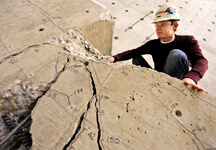Purdue working with NIST to improve building safety

Jeff M. Rautenberg, a Purdue civil engineering graduate student, measures cracks in a reinforced beam during an experiment to determine what happens in a disaster that takes out support columns. The work is aimed at helping the National Institute of Standards and Technology ensure that buildings are safe from natural and human-caused disasters that could knock out a vital supporting column. (Purdue University photo/ Andrew Hancock)
WEST LAFAYETTE, Ind. - Civil engineers at Purdue University are helping the Commerce Department's National Institute of Standards and Technology keep buildings safe from natural and human-caused disasters.
"Our current focus is on preventing collapses of buildings in a chain-reaction manner that may result from loss of a critical supporting column," said H.S. Lew, a senior research engineer in the NIST Building and Fire Research Laboratory in Gaithersburg, Md.
Purdue researchers are conducting full-scale tests to learn precisely what happens to a building structure when a single column is removed. Data collected with sensors will then be used by NIST to fine tune computational models to improve building code requirements, standards and practices.
"It's prohibitively costly to test a three-dimensional multistory building," Lew said. "We need to be able to predict how a given design will behave if a column is destroyed either from a natural disaster, an accident or a deliberate attack. For example, if a corner column is knocked out, will the building collapse or will it stay up long enough for occupants to evacuate?"
The researchers are trying to prevent "disproportionate collapse," or devastating damage caused after the loss of only a single column or small group of supporting structures.
"In designing modern buildings using advanced computational tools, we tend to shave away as much material as possible to make them as economically as we can," Lew said. "But a problem is that then there isn't much reserve capacity to sustain the loss of structural elements such as columns."
For example, much of the Alfred P. Murrah Federal Building in Oklahoma City collapsed, even though only two columns were knocked out by the 1995 bomb attack, he said.
Current detailed computer models take too long to run to be useful for day-to-day routine design of buildings. So researchers are developing a simplified, yet accurate, computational models using data from tests including the Purdue experiments.
The Purdue portion of the research is based at the university's Robert L. and Terry L. Bowen Laboratory for Large-Scale Civil Engineering Research.
"One special thing about these experiments is the size of the specimens," said Santiago Pujol, an assistant professor of civil engineering who is leading the Purdue testing. "Purdue's Bowen lab is one of the few research centers in the nation that has the physical capability and the experimental tradition to tackle a project of this size and complexity."
The Purdue researchers have tested a 40-foot-long full-scale assembly of reinforced concrete beams and columns and are starting the construction and instrumentation of a second one.
A live view of the experiment taken with a camera mounted in the lab can be accessed at https://bigwall.ecn.purdue.edu:51000/view/index.shtml
The assembly will be tested several times, with data collected from electronic and optical "displacement sensors" and a high-speed camera operated at 10,000 frames per second to track minute movements as the beam collapses. The research, to be completed in the summer, involves graduate and undergraduate students.
Results from NIST computer model simulations will be used by the building design and construction industries, as well as standards and code-making bodies, to help to ensure that future buildings possess the necessary reserve capacity to withstand damage from earthquakes, high winds and other causes.
"The series of experiments and their analyses will provide a rare environment for the education of future engineers," said Mete A. Sozen, Purdue's Kettelhut Distinguished Professor of Structural Engineering.
Writer: Emil Venere, 765-494-4709, venere@purdue.edu
Sources: H.S. Lew, 301-975-6060, hsl@nist.com
Santiago Pujol, 765-496-8368, spujol@purdue.edu
Mete A. Sozen, 765-494-2186, sozen@purdue.edu
Note to Journalists: Video is available by contacting James Schenke, 765-494-6262, jschenke@purdue.edu
